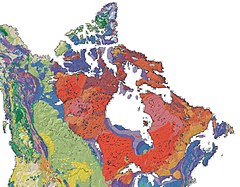
Back Kanadese Skild Afrikaans الدرع الكندي Arabic Escudu Canadianu AST Канадскі шчыт Byelorussian Канадски щит Bulgarian কানাডীয় শিল্ড অঞ্চল Bengali/Bangla Kanadski štit BS Escut canadenc Catalan Kanadský štít Czech Tariandir Canada Welsh
| Canadian Shield | |
|---|---|
| Stratigraphic range: | |
| Type | Shield |
| Unit of | North American craton |
| Sub-units | Laurentian Upland Kazan[1] |
| Area | 8,000,000 km2[2] |
| Location | |
| Coordinates | 52°00′N 71°00′W / 52.000°N 71.000°W |
| Region | North America |
| Country | Canada United States Greenland |
 The Canadian Shield is a broad region of Precambrian rock (pictured in shades of red) that encircles Hudson Bay. It spans eastern, northeastern, and east-central Canada and the upper midwestern United States. | |
The Canadian Shield (French: Bouclier canadien [buklje kanadjɛ̃]), also called the Laurentian Shield or the Laurentian Plateau, is a geologic shield, a large area of exposed Precambrian igneous and high-grade metamorphic rocks. It forms the North American Craton (or Laurentia), the ancient geologic core of the North American continent. Glaciation has left the area with only a thin layer of soil, through which exposures of igneous bedrock resulting from its long volcanic history are frequently visible.[3] As a deep, common, joined bedrock region in eastern and central Canada, the shield stretches north from the Great Lakes to the Arctic Ocean, covering over half of Canada and most of Greenland; it also extends south into the northern reaches of the continental United States.
© MMXXIII Rich X Search. We shall prevail. All rights reserved. Rich X Search